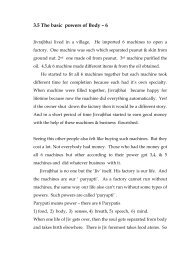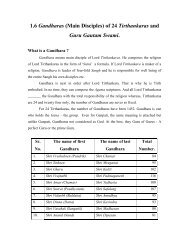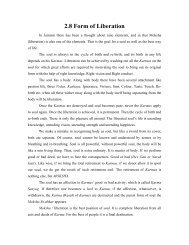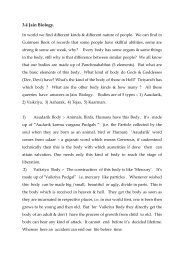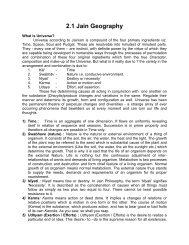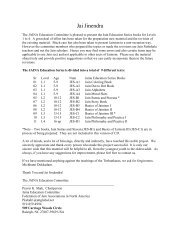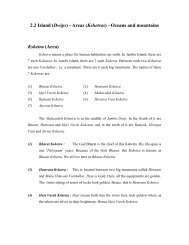âæ¢ ç¸ï¼¯ï¼ è£æ½® J - Jainism, Jain Religion - colleges
âæ¢ ç¸ï¼¯ï¼ è£æ½® J - Jainism, Jain Religion - colleges
âæ¢ ç¸ï¼¯ï¼ è£æ½® J - Jainism, Jain Religion - colleges
You also want an ePaper? Increase the reach of your titles
YUMPU automatically turns print PDFs into web optimized ePapers that Google loves.
THE FIVE AUSPICIOUS EVENTS IN THE LIFE OF THE TIRTHANKAR<br />
A Tirthankar is a highly elevated and supremely perfect soul. His life is not only for purification and elevation of his own soul,<br />
but also the source of inspiration for development and consequent welfare of humanity. As such, the birth of a Tirthankar is<br />
termed as ‘Janma Kalyanak’ or the auspicious birth. It is true for other such important events in his life including renunciation<br />
and liberation.<br />
In the <strong>Jain</strong> scriptures there is mention of five such auspicious events in the life of every Tirthankar:<br />
1. Chyavan Kalyanak (the auspicious descent) - To take birth as a human being, the soul descends from various dimensions<br />
of gods. This event is known as the auspicious descent. At this moment of descent the conceiving mother dreams<br />
of fourteen auspicious things. The incident of transplanting of foetus in the womb of Trishla Kshatriyani is an incident<br />
unique to Bhagavan Mahavir’s life.<br />
2. Janma Kalyanak (the auspicious birth) - This is the event of taking birth. After the birth fifty-six goddesses of directions<br />
arrive and do the post birth cleaning and other rituals. The king of gods creates his vie look-alike bodies and takes the<br />
„±üü ¿¢¢Ý¢² ½±¼é J<br />
newborn Tirthankar to the Meru Mountain for the ritual celebrations of post birth anointing.<br />
3. Diksha Kalyanak (the auspicious renunciation) - When a Tirthankar renounces his mundane abode and life-style and<br />
proceeds to accept Diksha (initiation into the ascetic way of life), gods and humans assemble and take out a procession<br />
heading toward the spot of initiation. After arriving there the Tirthankar gives away all his possessions including ornaments<br />
and apparels, and pulls out five fistful of hair with his own hands.<br />
4. Kewalajnana Kalyanak (the auspicious omniscience) - Destroying the four vitiating karmas with the help of his superlative<br />
practices of discipline, penance and meditation, the Tirthankar acquires the all enlightening and unhindered knowledge<br />
and perception and becomes an omniscient. At this time gods and humans come to behold him and be blessed. The<br />
gods create a divine pavilion (Samavasaran) and celebrate the event.<br />
5. Nirvana Kalyanak (the auspicious liberation) - Destroying all the karmas the Tirthankar leaves his mundane body and<br />
gets liberated. This event of the disintegration of the liberated. This event of the disintegration of the physical body is<br />
celebrated as the Nirvana Kalyanak or the auspicious liberation. (Illustrations overleaf).<br />
LIFE AS HOUSEHOLDER<br />
Conditions before the Birth<br />
About 2594 years back (599 B.C.) in the eastern region of India, a bright source of spiritual light dawned. He became famous<br />
as Vardhaman Mahavir.<br />
During the period of Bhagavan Parshvanath, the feudal system of rule prevailed in India. However, the beginnings of democratic<br />
system had started<br />
jainuniversity.org<br />
appearing on the political scene. It was the dawn of the localized republics. After his Nirvana the<br />
republics started expanding and Vaishali emerged as the capital of the federation of small republics. Maharaj Chetak, a<br />
staunch follower of the Parshva Tradition, was the president of the Vaishali republic and the federation.<br />
On the northern shore of the Ganges a large and powerful group of Lichhavi Kshatriyas favored democratic system. The six<br />
prominent clans that formed this republic were-Ugra, Bhog, Rajanya, Ikshvaku, Lichhavi, Jnat, and Kaurav, and nine chiefs<br />
represented them.<br />
Another union was named Malla and it was divided into two parts- northwestern and southeastern. The capital city of northwest<br />
was Kushinara and that of southeast was Pava. The nine chiefs of the Federation of Malla republics were also staunch<br />
supporters of the democratic system. Nine Mallas and nine Lichhavis combined to form an well-organized apex union called<br />
the Union of Vajji Republics. The Lichhavis of the Vaishali republic were Suryavanshi Kshatriyas, the descendents of Maryada<br />
Purushottam Ram. Before the advent of Bhagavan Mahavir and the Buddha, these were famous as the Videhas, but later,<br />
the name Lichhavi became more popular. Still, as a cultural group they always retained their identity as the Videhas. In the<br />
<strong>Jain</strong> literature Maharaj Chetak has been mentioned as Videhraj, his sister, Trishla, as Videhdinna. Mahavir has also been<br />
mentioned as Videh Sukumal. All this is indicative of the higher religious and cultural status of the state of Videh.<br />
The Royal Family of Vaishali<br />
To the north of Vaishali, there was a suburb named Kundpur Sannivesh. There was a colony of Brahmans in the southern<br />
parts of Kundpur. The chief of these Brahmans was Rishabhadatta and his wife was Devananda. Although a rich Brahman<br />
and a scholar of the Vedas and Vedangas, Rishabhdatta was a devotee of Bhagavan Parshvanath.<br />
In the northern parts of Kundpur there was a colony of Kshatriyas of the Jnat clan. The colony was known as Kshatriya<br />
Kundpur. Siddharth was the chief here. Because of his great valor and wealth he was respectfully addressed as Raja or<br />
Narendra. He was a highly influential member of the Vaishali republic.<br />
Trishla, the sister of president Chetak of Vaishali, was married to Siddharth; she was also known as Videhdinna and Priyakarini,<br />
Amar Muni - Tirthankar Charitra - Surana # 31<br />
www.jainuniversity.org




